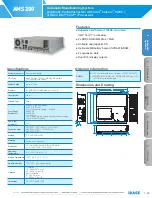
Ampcontrol Pty Ltd
– ABN 28 000 915 542
OCS USER MANUAL
MAG-182 Version 5
– FEB/2020
Uncontrolled Copy - Refer to Ampcontrol Website for Latest Version
Page 42 of 72
A
P
P
R
OV
E
D
FOR
E
X
T
E
R
N
A
L
D
IS
TR
IB
U
T
ION
–
P
R
OP
E
R
T
Y
OF
A
M
P
C
ON
TR
OL
P
T
Y
LTD
–
N
O
T
T
O
B
E
R
E
P
R
OD
U
C
E
D
I
N
P
A
R
T
NOTE
1. The per unit current is clipped to a maximum of 1250%. Therefore
the trip time for input currents above this level will not decrease any
further: ie, the trip characteristic ‘flat lines’ beyond 1250% of the
selected full load current.
2. Independent of the selected TMS setting, the minimum trip times for
the Overload function is nominally 100 ms.
3. The trip times calculated from the above formulae are idealized. The
trip calculations are executed every 20 ms, so there is an additional
delay and uncertainty of 25 ms +/-15 ms.
4. The above characteristic is equivalent to IEC 60255-8 (equation
below) with the substitution of
𝝉
=TMS • 72.9. This scaling aligns the
trip time at 10 PU current with that of the Extremely Inverse curve
above (e.g. 808ms with a TMS of 1.0).
𝑡 = 𝜏 ∙ ln (
𝐼
2
− 𝐼
𝑝
2
𝐼
2
− (𝑘 ∙ 𝐼
𝐵
)
2
)
Where in the Protection Element:
k = 1.05, called the
‘Service Factor’
IB = 1.
The base thermal model provides a thermal time constant of 72.9 seconds. The TMS setting scales the
basic thermal time constant, allowing a maximum time constant of over 36 minutes (TMS = 30).
See Motor Overload Curves drawing OCSB002in APPENDIX B: DRAWINGS.
The TAC provides information about how much thermal capacity is left, and therefore how long it will
take to trip from a given starting point and overload current. If the motor current I is constant (and below
1.05PU), the TAC will eventually settle to a value as follows:
𝑇𝐴𝐶 = (
𝐼
1.05
)
2
∙ 100 %
For example, if the long term average load current was 0.7PU, the TAC would settle at 44%.
The relative trip time for a constant current as a function of the initial value of the TAC is given by:
𝑡(𝑇𝐴𝐶) = ( 100% − 𝑇𝐴𝐶 ) ∙ 𝐶𝑜𝑙𝑑 𝑇𝑟𝑖𝑝 𝑇𝑖𝑚𝑒
Continuing the example above, with the TAC starting at 44%, the trip time would be 56% of the cold trip
time (for the same current), that is, if the long term average current (Ip) prior to an overload was 0.7PU,
the trip time for an over an overload from that starting point would be 56 % of the trip time for the same
overload current starting from cold. Drawing OCSB002also shows the overload curve for various values
of Ip.
The motor manufacturer’s data should be consulted to select the time multiplier appropriate for the motor
being protected. Typically, the capacity of a cold motor is given at six times its rated current. The
characteristic equation above can be used to select the TMS to match the motors overload capacity.
While the main contactor is closed, the cooling output from the thermal model is calculated to achieve
the necessary behaviour to match the characteristic above.
The Over Load Cooling Multiplier modifies the cooling output of the thermal model when the motor is
















































